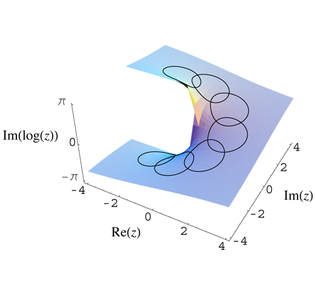
Summary
In complex analysis, the monodromy theorem is an important result about analytic continuation of a complex-analytic function to a larger set. The idea is that one can extend a complex-analytic function (from here on called simply analytic function) along curves starting in the original domain of the function and ending in the larger set. A potential problem of this analytic continuation along a curve strategy is there are usually many curves which end up at the same point in the larger set. The monodromy theorem gives sufficient conditions for analytic continuation to give the same value at a given point regardless of the curve used to get there, so that the resulting extended analytic function is well-defined and single-valued.


Before stating this theorem it is necessary to define analytic continuation along a curve and study its properties.
Analytic continuation along a curve edit
The definition of analytic continuation along a curve is a bit technical, but the basic idea is that one starts with an analytic function defined around a point, and one extends that function along a curve via analytic functions defined on small overlapping disks covering that curve.
Formally, consider a curve (a continuous function) Let be an analytic function defined on an open disk centered at An analytic continuation of the pair along is a collection of pairs for such that
- and
- For each is an open disk centered at and is an analytic function.
- For each there exists such that for all with one has that (which implies that and have a non-empty intersection) and the functions and coincide on the intersection
Properties of analytic continuation along a curve edit
Analytic continuation along a curve is essentially unique, in the sense that given two analytic continuations and of along the functions and coincide on Informally, this says that any two analytic continuations of along will end up with the same values in a neighborhood of
If the curve is closed (that is, ), one need not have equal in a neighborhood of For example, if one starts at a point with and the complex logarithm defined in a neighborhood of this point, and one lets be the circle of radius centered at the origin (traveled counterclockwise from ), then by doing an analytic continuation along this curve one will end up with a value of the logarithm at which is plus the original value (see the second illustration on the right).
Monodromy theorem edit
As noted earlier, two analytic continuations along the same curve yield the same result at the curve's endpoint. However, given two different curves branching out from the same point around which an analytic function is defined, with the curves reconnecting at the end, it is not true in general that the analytic continuations of that function along the two curves will yield the same value at their common endpoint.
Indeed, one can consider, as in the previous section, the complex logarithm defined in a neighborhood of a point and the circle centered at the origin and radius Then, it is possible to travel from to in two ways, counterclockwise, on the upper half-plane arc of this circle, and clockwise, on the lower half-plane arc. The values of the logarithm at obtained by analytic continuation along these two arcs will differ by
If, however, one can continuously deform one of the curves into another while keeping the starting points and ending points fixed, and analytic continuation is possible on each of the intermediate curves, then the analytic continuations along the two curves will yield the same results at their common endpoint. This is called the monodromy theorem and its statement is made precise below.
- Let be an open disk in the complex plane centered at a point and be a complex-analytic function. Let be another point in the complex plane. If there exists a family of curves with such that and for all the function is continuous, and for each it is possible to do an analytic continuation of along then the analytic continuations of along and will yield the same values at
The monodromy theorem makes it possible to extend an analytic function to a larger set via curves connecting a point in the original domain of the function to points in the larger set. The theorem below which states that is also called the monodromy theorem.
- Let be an open disk in the complex plane centered at a point and be a complex-analytic function. If is an open simply-connected set containing and it is possible to perform an analytic continuation of on any curve contained in which starts at then admits a direct analytic continuation to meaning that there exists a complex-analytic function whose restriction to is
See also edit
References edit
- Krantz, Steven G. (1999). Handbook of complex variables. Birkhäuser. ISBN 0-8176-4011-8.
- Jones, Gareth A.; Singerman, David (1987). Complex functions: an algebraic and geometric viewpoint. Cambridge University Press. ISBN 0-521-31366-X.
- Triebel, Hans (1986). Analysis and mathematical physics, English ed. D. Reidel Pub. Co. ISBN 90-277-2077-0.
External links edit
- Monodromy theorem at MathWorld
- Monodromy theorem at PlanetMath.
- Monodromy theorem at the Encyclopaedia of Mathematics



